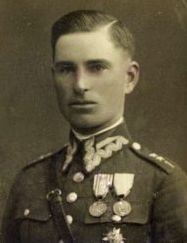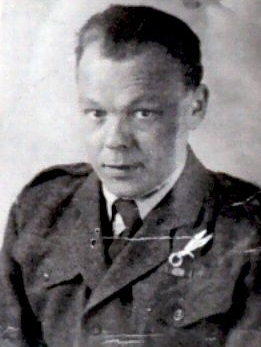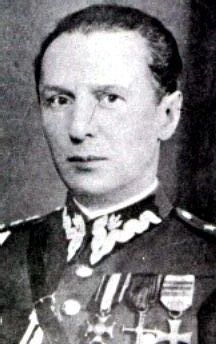|
It all began on 22 February 1944, when a signal from MAAF
(Mediterranean Allied Air Force) was received by HQ 249 Wing requesting that one Dakota of 267 Squadron be provided to carry
out a very special operation. This followed permission from the Polish 6th
Bureau and the Air Ministry granted as far back as May 1943 for the operation to take place.
No further details were provided, until a conference held at Brindisi and the nature of the operation was learnt.
The intention was to land in enemy occupied Poland in the
middle of the night to fly in two important agents and fly out the GOC of the Polish underground army (Armia Krajowa –
AK) together with four members of his staff and numerous intelligence reports. It
was revealed that the safe rescue of these officers from Poland would, to a certain extent, have a material effect on the
conclusion of the war. Complete secrecy was obviously demanded.
A total of six crews volunteered for this mission, without
knowing the details, and lots were drawn with the luck of the game falling to:
- Flight
Lieutenant Edward Joseph Harrod, Pilot
|
|
- Flight
Lieutenant Bolesław Korpowski (1586 Polish Flight), 2nd Pilot
|
|
- Pilot
Officer John Anthony Wells (Aus 407927), Navigator
|
|
- Pilot
Officer Noel Wilcock (172889), Wireless Operator – Air.
|
|
An aircraft, Dakota FD919, was set aside and fitted with
eight long-range fuel tanks, giving it a flying time of about eighteen hours. The
crew were taken off normal duties and spent the time studying plans and maps of the area and keeping their hand in by night
flying on supply drop operations over Yugoslavia. They went on standby for the
operation in mid-March 1944 and suffered intense bouts of anxiety and stress during this waiting period. On numerous occasions they were given the go-ahead, only to have the trip cancelled at the last minute. Many times they were actually airborne, waiting for the green light, when the radio
would play the Warsaw Concerto, the signal to abort, and they would return to base yet again, held back by adverse weather
or ground conditions. Needless to say, this beautiful piece of music was not
the crews’ favourite after a few of these exercises!
Finally, on 15 April 1944, they were given the nod and set
off from Brindisi at 17h32Z, crossing the Dalmatian coast at 10,000 feet and setting course for a pinpoint landmark on the
River Danube. They reached this mark without mishap and headed for the Vistula
River. On crossing the Carpathian Mountains, the weather deteriorated and they
flew in and out of cloud, relying entirely on Dead Reckoning navigation. Wells
and Wilcock certainly earned their keep during this stretch, using radio fixes from enemy radio stations as the only means
of navigation available!
Passing Budapest they encountered searchlights and some
flak, then the weather cleared after crossing the Carpathians, enabling Wells to get a decent fix on the stars, which showed
a higher ground speed than expected, altering their ETA at the Vistula. They
began a slow descent, crossing the pinpoint mark on the Vistula at 2,000 feet, as planned, and heading for the target on a
course almost parallel to the river.
|
|
RAF sketch of Landing Zone |
With 40 seconds to go before ETA, they began a series of
‘S’ turns over the target area, flashing their downward identification light.
This was answered almost immediately from the ground and the group of waiting partisans eagerly lit the hurricane lamps
marking the edges of the landing strip in white, and the green and red flares at each end of the zone.
Without wasting any time with the niceties of studying the
ground layout over-precautiously, Harrod undertook a normal approach, aiming to come in over the green lights at zero feet. As he did so, he switched on his landing lights and saw to his horror that he was
coming in way too fast and heading rapidly for the red lights and farm building at the end of the strip, forcing him to pull
up sharply for a second approach. Sensing that something was not right, he approached
gingerly at stall speed and landed quite heavily just inside the green lights, but still saw the red lights approaching far
too fast. He immediately applied the brakes with the tail still up and this,
coupled with the boggy nature of the ground, enabled him to bring the aircraft to rest within just 25 yards of a large barn.
As planned, the plane turned and headed back to the green
lights to meet the ground party. The soft ground meant the craft had to be kept
at full throttle the whole time to avoid sinking and on arrival at the green end of the strip the crew discovered that the
ground party had changed the plans at the last minute, deciding to wait by the red lights in an effort to speed up the operation,
and putting the green at the wrong end of the field, resulting in a downwind landing which nearly had catastrophic consequences! No rational explanation was ever forthcoming as to why they had expected the Dakota
to land downwind then simply turn around and take off up wind!
The frustrated crew swung the heavy machine round once more
and headed back down the field, still at full throttle, where they at last met up with the ground group who emerged from the
adjoining farm buildings.
The passengers quickly disembarked, with time enough only
for a quick farewell and the surreptitious handing over of a congratulatory bottle of Scotch to the pilot by one of the agents. The departing passengers were:
Captain
Narcyz Lopianowski (codename "Sarna" after his favourite horse)
|

|
and
Lieutenant Tomasz Kostuch (“Bryla”) plus dispatches, and a cargo of US dollars and fake ID books for the AK.
|

|
| |
|
|
Without further ado, the waiting passengers boarded, consisting
of:
· General Stanislaw Tatar (aka Tabor or Turski) Deputy Chief-of-Staff, AK
|

|
· Lieutenant Colonel Ryszard Dorotycz-Malewicz – AK Head of Courier Operations
· Lieutenant Andrzej Pomian – AK Dept of Information and Propaganda
· Zygmunt Berezowski, Nationalist Party member
· Stanislaw Oltarzewski, Government Delegation member.
|
|
The doors were closed, Harrod turned the craft once more
with extreme difficulty and lined up with the hurricane lamps for a take off which he later confided he never expected to
succeed. In front of him lay barely 800 yards of extremely soft, boggy, ploughed
ground, ending in a row of trees, which cut at an angle across his path. Reaching
this remote spot and landing successfully had been an exercise in its own right – getting out of here again was to be
a further test of skill and courage!
After the excitement and stresses of the landing and take off, the return flight
was relatively calm and uneventful. They experienced further flak over Budapest
and took evasive action, then, with dawn approaching, as they crossed over the relative safety of the Adriatic, the pilot
broke two cardinal rules of flying and allowed the crew to pass around a cigarette and the bottle of clandestine Scotch in
celebration!
They landed at Brindisi at 03h45Z on 16 April 1944, where they were met by
a large reception committee of both RAF and Polish officers.
Three days later, after special dispensation had been granted to the crew,
they accompanied their Polish passengers on the final leg of the journey to London.
On the morning of 19 April 1944 they took off in another Dakota, assisted by another pilot and second navigator, flying
non-stop to Gibraltar then on to England the next day, delivering their valuable human cargo to London, from where General
Tatar was able to direct successfully the operations of the AK, together with the rest of the Polish government-in-exile operating
from London.
As their Wing Commander E W Whitaker stated in his report,
“This completed the last stage of what might be considered the most
epic flight of the war in an unarmed aircraft….. The weather conditions
during the operation had not been the best. The visibility was bad and only by flying below the haze was it possible to identify
pinpoints. As a navigational flight, the highest praise is due to all the crew for putting up such a superb effort in finding
a beetroot field nearly 800 miles inside enemy occupied territory at night in poor visibility……. The greatest credit must be given to the crew for courage and determination in successfully completing
a mission of the greatest importance and hazard.”
On Wednesday 26 April 1944, at a specially convened investiture, Flight Lieutenant
Harrod was decorated with the Silver Cross and created a member of the Military Order, Virtuti Militari, by the Polish Commander
in Chief, General Sosnkowski. Later he also was awarded the Distinguished Flying
Cross by King George.
|
|
Translated
from the Polish certificate:
“The Commander-in-Chief
by decree of
26.IV.1944
in recognition
of outstanding gallantry
has created
F/Lt E J Harrod
Member of the Military
Order
“Virtuti Militari”
and has conferred upon
him
the insignia
of the Silver Cross
of the Order.”
Gen. Sosnkowski
|
Return to top of page
|

